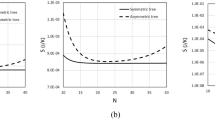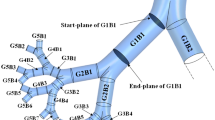Abstract
The design of the bronchial tree has largely been proposed as a model of optimal design from a physical-functional perspective. However, the distributive function of the airway may be more related to a geometrical than a physical problem. The bronchial tree must distribute a three dimensional volume of inspired air on a two dimensional alveolar surface, included in a limited volume. It is thus valid to ask whether an optimal bronchial tree from a physical perspective is also optimum from a geometrical point of view.
In this paper we generate a simple geometric model for the branching pattern of the bronchial tree, deducing relationships that permit estimation of the departures from the geometrical optimum of each bifurcation. We also, for comparative purposes, estimate the departures from the physical optimum. From the geometrical assumptions: i) a symmetrical dichotomic fractal design, ii) with minimum volume and iii) maximum dispersion of the terminal points; and several simulations we suggest that the optimality is characterized by a bifurcation angle Θ ∼ 60° and a length reduction scale γ = (1/2)1/3 = 0.7937. We propose distances from the physical and geometrical optimality defined as Euclidean distances from the expected optima. We show how the advanced relationships and the distances can be used to estimate departures from the optimality in bronchographs of four species. We found lower physical and geometrical departures in the distal zone than those of the proximal zones, as well as lower physical than geometrical departures from optimality.
Similar content being viewed by others
REFERENCES
Andrade, J.S., A.M. Alencar, M.P. Almeida, J. Mendes Filho, S.V. Buldyrev, S. Zapperi, H.E. Stanley and B. Suki (1998). Asymmetric flow in symmetric branched structures. Physical Review Letters 81: 926-929.
Bacigalupe, L.D. and F. Bozinovic (2002). Design, limitations and sustained metabolic rate: lessons from small mammals. The Journal of Experimental Biology 205: 2963-2970.
Canals, M., R. Olivares, F. Labra and F.F. Novoa (2000). Ontogenetic Changes in the fractal geometry of the bronchial tree in Rattus norvegicus. Biological Research 33: 31-35.
Canals, M., C. Atala, R. Olivares, F.F. Novoa and M. Rosenmann (2002a). La asimetría y el grado de optimización del árbol bronquial en Rattus norvegicus y Oryctolagus cuniculus. Revista Chilena de Historia Natural 75: 271-182.
Canals, M., C. Atala, R. Olivares, F.F. Novoa and M. Rosenmann (2002b). Departures from the optimality in the bronchial tree of rats (Rattus norvegicus). Biological Research 35:411-419.
Canals, M., R. Olivares, F. Labra, L. Caputo, A. Rivera and F.F. Novoa (1998). Caracterización de la geometría fractal del árbol bronquial en mamíferos. Revista Chilena de Anatomía 16: 237-244.
Dudley, R., and C. Gans (1991). A critique of symmorphosis and optimality models in physiology. Physiological Zoology 64: 627-637.
Dullemeijer, P. (1998). Optimality in the design of bony elements. In: Weibel, E.R., C.R. Taylor and L. Bolis (Eds). Principles of animal design. The optimization and symmorphosis debate. Cambridge: Cambridge University Press: 64-70.
Glenny, R. and H.T. Robertson (1990). Fractal properties of pulmonary blood flow: characterization of spatial heterogeneity. Journal of Applied Physiology 69: 532-545.
Garland, T. Jr. (1998). Conceptual and methodological issues in testing the predictions of symmorphosis. In: Weibel, E.R., C.R. Taylor and L. Bolis (Eds). Principles of Animal Design. The Optimization and Symmorphosis Debate. Cambridge University Press, Cambridge. pp. 40-47.
Gordon, M.S. (1998). Evolution of optimal solutions. In: Weibel, E.R., C.R. Taylor and L. Bolis (Eds). Principles of Animal Design. The Optimization and Symmorphosis debate. Cambridge University Press, Cambridge.
Horsfield, K. (1990). Diameters, generations and orders of branches in the bronchial tree. Journal of Applied Physiology 68: 457-461.
Horsfield, K. and G. Cumming (1968). Morphology of the bronchial tree in man. Journal of Applied Physiology 24: 373-383.
Horsfield, K., G. Dart, D.E. Olson, G.F. Filley and G. Cumming (1971). Models of the human bronchial tree. Journal of Applied Physiology 31: 201-217.
Kamiya, A., T. Togawa and A. Yamamoto (1974). Theoretical relationship between the optimal models of the vascular tree. Bulletin of Mathematical Biology 36: 311-323.
Kitaoka, H., R. Takaki and B. Suki (1999). A three dimensional model of the human airway tree. Journal of Applied Physiology 87: 2207-2217.
Kitaota, H. and B. Suki (1997). Branching design of the bronchial tree based on diameter-flow relationship. Journal of Applied Physiology 82: 968-976.
Mc Namee, J.E. (1991). Fractal perspectives in pulmonary physiology. Journal of Applied Physiology 71: 1-8.
Maina, J.N. and P. van Gils (2001). Morphometric characterization of the airway and vascular systems of the lung of the domestic pig, Sus scrofa: comparison of the airway, arterial and venous systems. Comparative Biochemistry and Physiology A 130: 781-798.
Mandelbrot B.B. (1982). The fractal geometry of nature. W.H. Freeman and Company, New York.
McNeill Alexander, R. (1995). Optima for animals. Princeton University Press, Princeton, New Jersey.
McNeill Alexander, R. (1998). Symmorphosis and safety factors. In: Weibel E.R., C.R. Taylor and L. Bolis (Eds). Principles of animal design. The optimization and symmorphosis debate. Cambridge University Press, Cambridge. pp. 28-36.
Murray, C.D. (1926). The physiological principle of minimum work. Proceedings of the National Academy of Science USA 12: 207-214.
Nelson, T.R., B.J. West and A.L. Goldberger (1990). The fractal lung: universal and species-related scaling patterns. Experientia 46: 251-254.
Ramchandani, R., J.H.T. Bates X. Shen, B. Suki and R.S. Tepper (2001). Airway branching morphology of mature and immature rabbit lungs. Journal of Applied Physiology 90: 1584-1592.
Rhorer, F. (1915). Flow resistance in human air passages and the effect of irregular branching of the bronchial system on the respiratory process in various regions of the lungs. Pfluegers Archives 162: 255-299.
Rigaut, J.P. (1984). An empirical formulation relating boundary lenghts to resolution in specimens showing “non ideally fractal” dimensions. Journal of Microscopy 133: 41-54.
Thurlbeck, A. and K. Horsfield (1980). Branching angles in the bronchial tree related to order branching. Respiration Physiology 41: 173-181.
Weibel, E.R. (1963). Morphometry of the human lung. Academic Press, New York.
Weibel, E.R., and D.M. Gomez (1962). Architecture of the human lung. Science 137: 577-585.
Weibel, E.R., R. Taylor and L. Bolis (1998). Principles of Animal design: The optimization and symmorphosis debate. Cambridge University Press, Cambridge.
Weibel, E.R., R. Taylor and H. Hoppeler (1991a). The concept of symmorphosis: a testable hypothesis of structure function relationship. Proceedings of The Natural academy Science 88: 10357-10361.
Weibel, E.R., R. Taylor and H. Hoppeler (1991b). Variation in function and design: testing symmorphosis in the respiratory system. Respiration Physiology 60: 325-348.
West, B.J., V. Bhargawa and A.L. Goldberger (1986). Beyond the principle of similitude: renormalization in the bronchial tree. Journal of Applied Physiology 60: 1089-1097.
West, G.B., J.H. Brown and B.J. Enquist (1997). A general model for the origin of allometric scaling laws in biology. Science 276: 122-126.
Wilson, T. (1967). Design of the bronchial tree. Nature 668-669.
Zamir, M. (1976). Optimality principles in arterial branching. Journal of Theoretical Biology 62: 227-251.
Zamir, M. (1978). Nonsymmetrical bifurcation in arterial branching. Journal of General Physiology 72: 837-845.
Zamir, M. (1986). Cost analysis of arterial branching in the cardiovascular system of man and animals. Journal of Theoretical Biology 120: 111-123.
Zamir, M. and D.C. Bigelow (1984). Cost of departure from optimality in arterial branching. Journal of Theoretical Biology 109: 401-409.
Author information
Authors and Affiliations
Rights and permissions
About this article
Cite this article
Canals, M., Novoa, F.F. & Rosenmann, M. A Simple Geometrical Pattern for the Branching Distribution of the Bronchial Tree, Useful to Estimate Optimality Departures. Acta Biotheor 52, 1–16 (2004). https://doi.org/10.1023/B:ACBI.0000015909.97029.c8
Issue Date:
DOI: https://doi.org/10.1023/B:ACBI.0000015909.97029.c8




